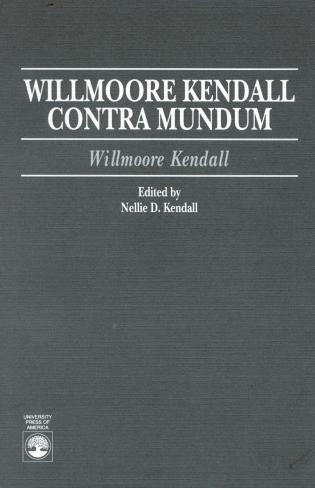
In a short essay published in the winter of 1964-1965 called “Equality and the American Political Tradition”, the great conservative philosopher Willmoore Kendall discusses the issue of equality in the United States of America.
He recognises that the Declaration of Independence puts forth, as the very first of the truths the people in the United States hold as self-evident, the proposition that “all men are created equal”.
However, such apparent right to equality possesses a first weakness. The proposition “all men are created equal”, even at the moment that it was uttered, meant quite different things to different persons. At least, Prof. Kendall identifies six different meanings.
To some it merely meant that all men were created equal in the eyes of God. To other it meant that all men were created with an equal claim to justice under the existing laws. For another group, it expressed the hope -and only a hope- that the republic about to be formed would be the land, the first land of all lands ever and anywhere, in which men would become equal, that is, achieve the equality of which humble and disadvantaged men have often dreamt dreams that other men have called Utopian. A fourth interpretation allowed the hope that the USA would be a land in which inequalities among men would be less glaring, less intimately related to what we call the accident of birth, less likely to be handed down to later generations.
But still there could be a further differing interpretation, namely, a hope that the new republic would be one in which men -white men, and male men only, not female men- would cast equal votes in at least some elections for public office. Or, as a sixth possibility, the hope that the US would be a land in which government, that is, political authority, would take steps to make men equal; at least, Prof. Kendall refers this as a possibility, perhaps just as a hypothesis, as it amounts to Communism.
There can still be, of course, multiple combinations of the former. And yet, a second problem arises with considering such ambiguous equality as a right: the proclaimed proposition of the Declaration of Independence was not mentioned by the Framers of the Philadelphia Constitution.
And this was not done even in the Preamble, where they pause to list the purposes for which the people of the US ordain and establish such Constitution: a more perfect union, and the blessings of liberty and justice, among other – but with no trace about equality.
Moreover, when Madison, during the First Session of Congress, penned the Bill of Rights, he also failed to mention equality. So Prof. Kendall concludes that the idea of equality disappeared from the main United States political documents after the Declaration of Independence.
It reappeared after the Civil War in the Fourteenth Amendment, restoring the word “equal” to the nation’s political vocabulary. But it expressly referred to “equal protection of the laws”, which in turn can mean either of two alternatives.
On the one hand, it can be read as granting all men a right to have the equal protection of the existing laws; on the other, all men may be entitled to laws that in fact give equal protection to each. Only this second interpretation would grant a man the right to go into the courts so that a law could be declared unconstitutional for contradicting the Fourteenth Amendment.
Such an interpretation allows, according to Prof. Kendall, a legal revolution presided over the Supreme Court against Congress and State legislatures. The Supreme Court first adhered to the first interpretation during decades, but then went on to revise and reinterpret state laws so as to in fact give equal protection to all and forbid discrimination in favour of some persons and against other persons.
Nevertheless, our author argues that such an interpretation contradicts -even implicitly repeals- the Tenth Amendment of the Constitution, which forbids federal authorities to make decisions on suffrage, education or religion, where evidently there can be issues about equality.
Source of image: Rowman & Littlefield



 Subscribe
Subscribe